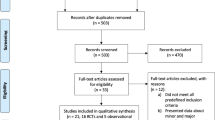Abstract
Background
Nonobese patients undergoing laparoscopic procedures present a dilemma as to the correct mode of entry into the abdominal cavity because the Veress needle (VN) technique seems to be associated with a high risk of vascular and visceral injuries. Direct trocar insertion (DTI) has been reported as an alternative to the VN for creation of the pneumoperitoneum.
Methods
An open comparative randomized prospective study was conducted on the feasibility and safety of DTI vs the VN technique in nonobese patients of any age category referred for urgent or scheduled laparoscopic procedures. Exclusion criteria were obesity (defined as a body mass index [BMI] > 27 kg/m2), major abdominal distension, and two or more previous abdominal operations. The study endpoints were the feasibility and safety of the DTI and VN techniques. Results were evaluated on an intention-to-treat basis. Statistical analysis was carried out with the t-test for independent samples, the chi-square tests, and the Fisher’s exact tests, as appropriate. The level of significance was 0.01.
Results
Since January 2002, a total of 598 nonobese patients have been entered into the current trial; 46% (mean BMI 21.6 ± 4.4 kg/m2) were randomly allocated to DTI, whereas 54% (BMI 21.1 ± 5.3 kg/m2) were allocated to the VN techniques. Demographic features and type of procedures were similar for the two groups. DTI was feasible in 100% of patients vs 98.7% in the VN group (p = NS). Minor complications were nil in the DTI group and 5.9% in the VN group (p < 0.01). The latter group consisted of 11 cases (3.4%) of subcutaneous emphysema and eight cases (2.5%) of extraperitoneal insufflation. Major complications were nil in the DTI group and 1.3% among VN patients (p = NS). These latter cases consisted of two (0.3%) hepatic lesions managed laparoscopically; one (0.3%) misdiagnosed ileal perforation requiring reintervention, and one (0.3%) mesenteric laceration treated conservatively.
Conclusion
In thin and very thin patients of any age category with no more than one previous abdominal operation, DTI is a safe alternative to the VN technique and is associated with fewer minor complications. In terms of major complications, there is no difference between the two techniques. Either technique of access is acceptable Thin and very thin patients undergoing laparoscopy, on condition that the basic principles of laparoscopic surgery are complied with.
Similar content being viewed by others
References
L Borgatta L Gruss D Barad (1990) ArticleTitleDirect trocar insertion vs. Veress needle use for laparoscopic sterilization J Reprod Med 35 891–894 Occurrence Handle1:STN:280:DyaK3M%2FjvFSrsQ%3D%3D Occurrence Handle2146389
JW Byron G Markenson K Miyazawa (1993) ArticleTitleA randomized comparison of Veress needle and direct trocar insertion for laparoscopy Surg Gynecol Obstet 177 259–262 Occurrence Handle1:STN:280:DyaK3szmt1Sgug%3D%3D Occurrence Handle8356499
M Catarci M Carlini P Gentileschi E Santoro (2001) ArticleTitleMajor and minor injuries during the creation of pneumoperitoneum: a multicenter study on 12,919 cases Surg Endosc 15 566–569 Occurrence Handle1:STN:280:DC%2BD3MrksV2nsw%3D%3D Occurrence Handle10.1007/s004640000381 Occurrence Handle11591941
C Copeland R Wing JF Huka (1983) ArticleTitleDirect trocar insertion at laparoscopy: an evaluation Obstet Gynecol 62 665–669
JR Dingfelder (1978) ArticleTitleDirect laparoscope trocar insertion without prior pneumoperitoneum J Reprod Med 21 45–47 Occurrence Handle1:STN:280:DyaE1M%2FgslelsQ%3D%3D Occurrence Handle151144
MT Jacobson J Osias R Bizhang M Tsang S Lata M Helmy C Nezhat et al. (2002) ArticleTitleThe direct trocar technique: an alternative approach to abdominal entry for laparoscopy JSLS 6 169–174 Occurrence Handle12113423 Occurrence Handle3043410
JC Jarrett Suffix2nd (1990) ArticleTitleLaparoscopy: direct trocar insertion without pneumoperitoneum Obstet Gynecol 75 725–727 Occurrence Handle2138267
D Molloy PD Kaloo M Cooper TV Nguyen (2002) ArticleTitleLaparoscopic entry: a literature review and analysis of technique and complications of primary port entry Aust N Z J Obstet Gynaecol 42 246–254 Occurrence Handle10.1111/j.0004-8666.2002.00246.x Occurrence Handle12230057
FR Nezhat SL Silfen D Evans C Nezhat (1991) ArticleTitleComparison of direct insertion of disposable and standard reusable laparoscopic trocars and previous pneumoperitoneum with Veress needle Obstet Gynecol 78 148–150 Occurrence Handle1:STN:280:DyaK3M3mtFehtQ%3D%3D Occurrence Handle1828549
AJ Penfield (1985) ArticleTitleHow to prevent complications of open laparoscopy J Reprod Med 30 660–663 Occurrence Handle1:STN:280:DyaL28%2FjslWjsw%3D%3D Occurrence Handle2932552
PA Philips FA Amaral (2001) ArticleTitleAbdominal access complications in laparoscopic surgery J Am Coll Surg 192 525–536 Occurrence Handle1:STN:280:DC%2BD3M3ivFSrsg%3D%3D Occurrence Handle10.1016/S1072-7515(01)00768-2 Occurrence Handle11294410
JL Ponsky (1991) ArticleTitleComplications of laparoscopic cholecystectomy Am J Surg 161 393–395 Occurrence Handle1:STN:280:DyaK3M7lvVSqsQ%3D%3D Occurrence Handle10.1016/0002-9610(91)90605-D Occurrence Handle1825765
M Schafer M Lauper L Krahenbuhl (2001) ArticleTitleTrocar and Veress needle injuries during laparoscopy Surg Endosc 15 275–280 Occurrence Handle1:STN:280:DC%2BD38%2FgvFyjtQ%3D%3D Occurrence Handle10.1007/s004640000337 Occurrence Handle11344428
MA Yerdel K Karayalcin A Koyuncu B Akin C Koksoy AG Turkcapar N Erverdi et al. (1999) ArticleTitleDirect trocar insertion versus Veress needle insertion in laparoscopic cholecystectomy Am J Surg 177 247–249 Occurrence Handle1:STN:280:DyaK1M3jsFaksg%3D%3D Occurrence Handle10.1016/S0002-9610(99)00020-3 Occurrence Handle10219864
Author information
Authors and Affiliations
Corresponding author
Rights and permissions
About this article
Cite this article
Agresta, F., De Simone, P., Ciardo, L.F. et al. Direct trocar insertion vs veress needle in nonobese patients undergoing laparoscopic procedures: a randomized prospective single-center study. Surg Endosc 18, 1778–1781 (2004). https://doi.org/10.1007/s00464-004-9010-y
Received:
Accepted:
Published:
Issue Date:
DOI: https://doi.org/10.1007/s00464-004-9010-y




